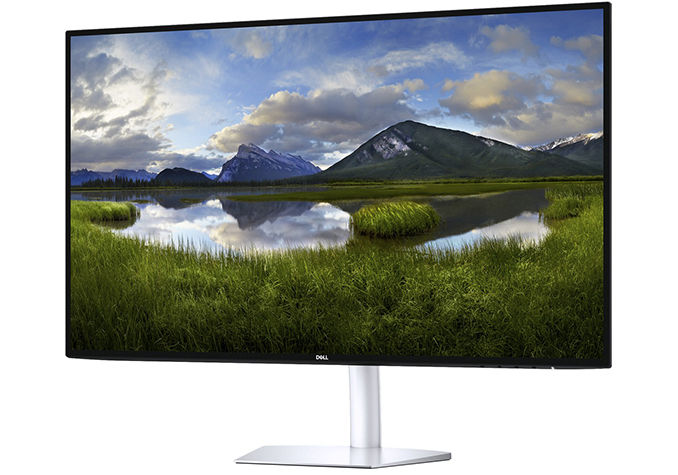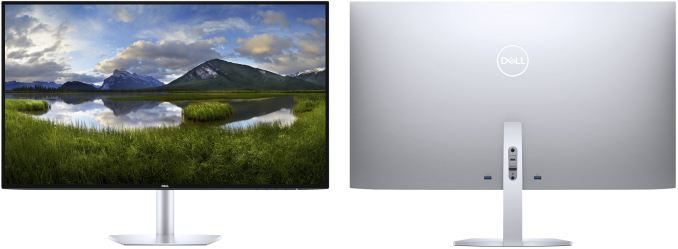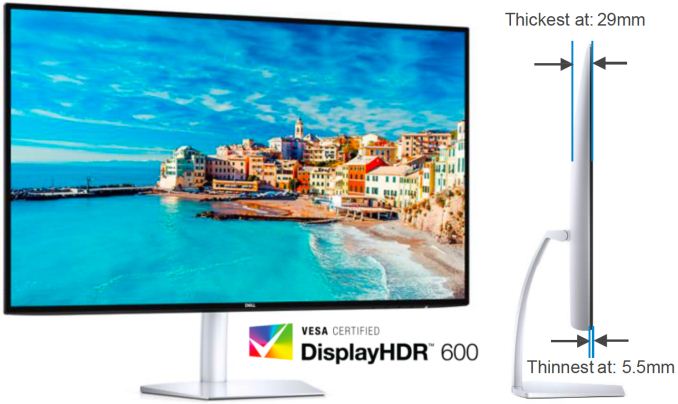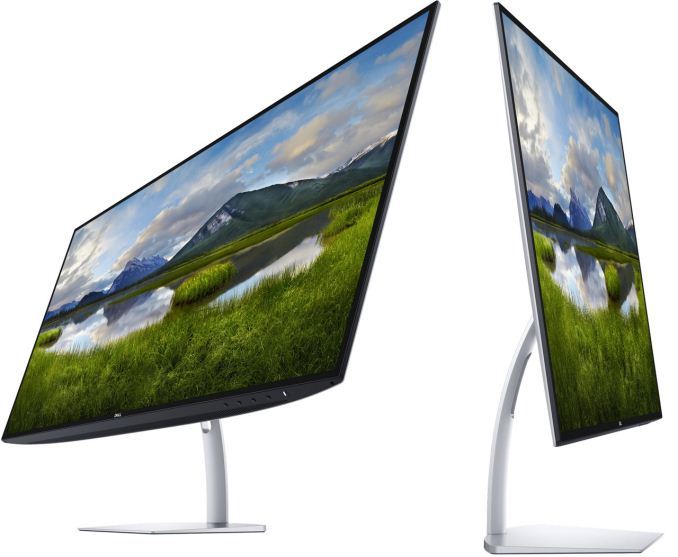Dell Announces Ultrathin S2719DC LCD: FreeSync USB-C with HDR600
by Anton Shilov on August 29, 2018 1:15 AM EST
Dell has introduced its new Ultrathin 27-inch display that features a USB Type-C interface for modern PCs. The S2719DC is aimed primarily at space-constrained business environments, but in addition to being thin and featuring a modern interconnection, the new monitor also carries VESA’s DisplayHDR 600 badge, supports AMD’s FreeSync, and covers 90% of the DCI-P3 color gamut, three important features for multimedia enthusiasts.
General specifications of Dell’s Ultrathin S2719DC are pretty regular for a 27-inch display. The LCD is based on an 8-bit IPS panel with a 2560×1440 resolution, a 400/600 nits brightness (typical/peak), a 1000:1 contrast ratio, a 60 Hz refresh rate (with FreeSync), a 5 – 8 ms response time, and 178°/178° viewing angles. The monitor can display over 99% of the sRGB color gamut as well as 90% of the DCI-P3 palette, which is not typical for office displays. Besides, it also features VESA’s DisplayHDR 600 certificate and therefore can properly display HDR content with up to 600-nits peak brightness.
As far as connectivity is concerned, the Ultrathin S2719DC has one HDMI 2.0 and one USB Type-C input supporting DP-over-USB-C alt mode. In addition, the monitor has a dual-port USB 3.0 hub, and a 3.5-mm audio connector for headphones.
| Specifications of Dell's Ultrathin 27-Inch Display | ||
| S2719DC | ||
| Panel | 27" IPS | |
| Native Resolution | 2560 × 1440 | |
| Maximum Refresh Rate | 60 Hz | |
| Response Time (Grey-to-Grey) | 5 ms in fast mode 8 ms in normal mode |
|
| Brightness | Nominal: 400 cd/m² Peak in HDR: 600 |
|
| Contrast | 1000:1 | |
| Viewing Angles | 178°/178° horizontal/vertical | |
| Pixel Pitch | 0.233 × 0.233 mm | |
| PPI | 108 | |
| Color Gamut | 99% sRGB 90% DCI-P3 |
|
| Inputs | 1 × HDMI 1 × USB-C |
|
| Audio | 3.5-mm headphone jack | |
| USB | Dual-port USB 3.0 hub | |
| Power Consumption | Standby | 0.5 W |
| Maximum | 35 W | |
The main selling point of the Dell Ultrathin S2719DC monitor is its combination of extremely thin profile of 5.5 – 29 mm with DisplayHDR 600 label and a USB Type-C interface. At present, there are ultra-thin displays, there are LCDs that carry DisplayHDR 600 badge, and there are monitors that connect to hosts using a USB-C cable. Meanwhile Dell has managed to bring all three features together in a single product that can address a broad spectrum of customers.
Dell’s Ultrathin S2719DC display will be available from select retailers in the U.S. starting today at an MSRP of $549.99.
Related Reading:
- Dell at CES 2018: Ultrathin Monitors - InfinityEdge, IPS, DisplayHDR 400 Certified
- Dell’s UltraSharp U3818DW Now Available: Curved 37.5”, 3840×1600, USB-C, $1499
- Lenovo Unveils New ThinkVision X24 LCD: 4-mm Thick, Ultra-Thin Bezels, FHD, IPS
- Dell Announces UP2718Q HDR Display, And Two InfinityEdge Displays













12 Comments
View All Comments
Ej24 - Wednesday, August 29, 2018 - link
But can it be wall mounted? Or mounted on an arm?DanNeely - Wednesday, August 29, 2018 - link
Looking at the product shots probably not without some sort of custom adapter to plug into the arm socket and convert it to a standard VESA100 mount. It also looks like they're following various garbage fire race to the bottom brands in crippling the height adjustment to the ever stylish precariously piled stack of random books method.r3loaded - Wednesday, August 29, 2018 - link
> 8-bit IPS panel> HDR
These two shouldn't be a thing together. HDR ought to imply a 10-bit panel.
diehardmacfan - Wednesday, August 29, 2018 - link
Even the HDR 1000 spec doesn't require a true 10-bit panel.Blame VESA.
Ej24 - Wednesday, August 29, 2018 - link
Wow really? I had no idea that was the case.milkod2001 - Wednesday, August 29, 2018 - link
Why are are making 27''1440p monitors now? They were around for last decade already. 32''4k 100Hz factory calibrated screen under $1000 in 2018 would be very kind.DanNeely - Wednesday, August 29, 2018 - link
The same reason they're making 22/24" 1080p monitors and similar sized 1366x768 ones. Not everyone has an unlimited budget to buy a screen that can check every single feature box. If you don't care about the extra sharpness from high DPI (or are stuck working with software that face plants on HDPI), native 4k on anything smaller than a TV is a waste because you'd have to run the monitor in non-native resolution. For those customers picking features other than high DPI makes sense. And until AMD releases new faster GPUs next year, it's not like 4k freesync is that useful, you have to turn down the quality settings a lot to make it work with Vega.milkod2001 - Wednesday, August 29, 2018 - link
I do understand that they also make cheaper 1080p monitors. What i don't understand why they bother with 1440p monitors in 2018 ??? 4k is around for last 5 years plus...It looks to me that they intentionally are slowing down the progress. Tech is here already. There is no need for just another 60Hz 1440p monitor.
DanNeely - Wednesday, August 29, 2018 - link
It's the exact same reasons as 1080p.1080p is cheaper than 1440p as a monitor. 1440p is cheaper than 4k as a monitor. 1080p requires half the GPU to game as 1440p, that increases the cheapness factor of 1080p over 1440p. 1440p requires half the GPU to game as 4k, that increases the cheapness factor of 1440p. Vega can't do 4k without major quality setting sacrifices (and even in nvidia land 1080Ti is marginal, 20xx may change that but the higher prices cut away a lot of the nominal gain unless you can spend >$1k for the GPU), if you're gaming on AMD in 2018 1440p is a better fit than 4k. If you don't want to use HDPI 27" 1440p is a still reasonable 110DPI. 32" 4k is 140 DPI, for most people that's too small to use at native (if you can, enjoy your greater than 20:20 eyes while their youth lasts), getting 110DPI at 4k needs a 40" screen. That's enough bigger than 27 to be a no-go for lots of peoples desks.
Dug - Wednesday, August 29, 2018 - link
Actually the preference for most people is 100% scaling. On a 27" monitor you can't do that with 4k. If scaling wasn't an issue, and games could comfortably run at 4k, then I would say you are correct. But neither of those are true. The feature here is easy connection with USB and a far higher brightness level than you can currently get on any $500 ips monitor.